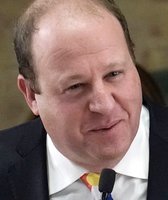Stand up for the facts!
Our only agenda is to publish the truth so you can be an informed participant in democracy.
We need your help.
I would like to contribute

An assembly line worker uncrates an LG battery at a General Motors facility in Lake Orion, Mich., in 2023. (AP)
Get ready: In the 2024 presidential race, the candidates will talk about the economy. A lot.
We know because it’s already happening.
Incumbent President Joe Biden has touted the rapid growth of jobs on his watch. His predecessor and front-runner for the Republican nomination, Donald Trump, has focused on the four-decade-high inflation that peaked in summer 2022.
Biden argues the economy has turned the corner on inflation. Trump, who leads former South Carolina Gov. Nikki Haley comfortably, counters that residual inflation continues to inflict economic pain.
Voters are listening.
When the Quinnipiac University poll asked respondents in February for what they thought was the most urgent issue facing the country, 20% said the economy — a close second behind preserving democracy at 21%. Among Republicans, 24% chose the economy (second to immigration at 35%) while 24% of independents picked the economy, making it their top issue.
With the Super Tuesday primaries coming this week, PolitiFact decided to look at a few common economic talking points in the presidential race. We compared the nation’s economic performance not just under Biden and Trump but also under their three predecessors: Barack Obama, George W. Bush, and Bill Clinton.
No president is all-powerful on economic matters. The severe but relatively brief interruption the coronavirus pandemic caused also makes comparisons tricky. And beyond the numbers are intangibles, such as leadership qualities.
There’s no simple answer for who has been the better economic steward. On the numbers, Biden has some advantages over Trump, and vice versa. Other economic statistics show both presidents putting up impressive numbers during their first three years in office. (Looking at the first three years in office was the fairest comparison, as Trump’s fourth year was walloped by the coronavirus pandemic, and Biden’s fourth year is just 2 months old.)
In January, Biden highlighted that Trump was the first president to oversee a net loss of jobs since Herbert Hoover, who was in office when the Great Depression hit — but failed to mention the 2020 pandemic caused the nosedive.
When excluding the pandemic year of 2020, we found that the economy under Biden added jobs at a faster rate than under Trump — and faster than any of Biden’s recent predecessors.
Under Biden, U.S. employment is now 10% above what it was when he was sworn in. Ranking second after three years is Clinton, with almost 8%, followed by Trump with 4.4%. Both Obama and Bush had fewer jobs filled after three years than they had on their first day in office.
Biden benefited from favorable timing. He was inaugurated January 2021, as the pandemic started receding. Although the jobs recovery began under Trump, Biden was blessed with a steady flow of Americans moving back into jobs that had been hampered during the pandemic.
Still, the simple return of workers sidetracked by the pandemic doesn’t explain all the job gains on Biden’s watch, even though Trump has tried to make that case. Employment data through Biden’s first three years in office significantly exceeds where the workforce stood before the pandemic.
Given that job creation was leveling off during Trump’s last few months in office, "it was not inevitable that we would get the huge bounceback we saw under Biden," said Dean Baker, co-founder of the liberal Center for Economic and Policy Research. Biden’s American Rescue Plan, a pandemic recovery bill passed weeks after Biden took office, "was a huge deal here."
Another factor in the expanding labor market — though one that’s become a political two-edged sword — has been higher immigration rates under Biden. This has helped fuel the economy, according to analyses by the nonpartisan Congressional Budget Office and others, even as it lets critics discuss chaos at the border.
Biden has emphasized the growth of manufacturing jobs when touting bills he’s signed into law, including the Bipartisan Infrastructure Law, the CHIPS and Science Act, and the Inflation Reduction Act.
The data shows that manufacturing jobs have grown by about 6.5% since Biden took office. Trump ranks second at 3.4%, followed by Clinton at 2.5%. Three years into their terms, Obama and Bush had both overseen losses in manufacturing jobs.
Biden and Trump have dueling messages on inflation, which peaked north of 9% in summer 2022. Economists generally blame pandemic-era supply chain problems, with Biden’s aid package exacerbating the rise in prices.
Biden has emphasized how much inflation has dropped.
"Wages are rising. Inflation is down," Biden said in a Feb. 12 speech in Washington, D.C., to the National Association of Counties. The following day, Biden applauded the release of new inflation statistics showing that prices had risen by 3.1% in the year ended January 2024, about one-third of the 2022 peak level. It remains a bit above the 2% that the Federal Reserve wants to see before lowering interest rates.
The biggest reasons inflation has eased, economists have told us, are factors that the administration doesn’t control: Federal Reserve interest rate hikes, a global oil price decline and a slowdown in China’s economy.
Inflation did not hamper Trump. During his first three years in office, Trump saw wages outpace inflation — the opposite of Biden.
For Biden, the data is improving, but that picture depends heavily on the time frame used.
If you start with Biden’s first day in office, prices have risen faster than wages — never a good sign for a president seeking reelection.
"In 2021 and 2022, people went to work and fell further behind," said Douglas Holtz-Eakin, president of the center-right American Action Forum. "They are not over it, despite the gains in 2023."
However, wage growth on Biden’s watch is on pace to exceed price growth within a couple of months. Also, wages have outpaced inflation for more than a year now, and wages have also outpaced inflation since Jan. 2020, the final month before the pandemic.
One difference between the Biden and Trump economies is data showing that the wage increases under Biden have been especially robust for poorer people.
Trump could make plenty of accurate claims about the pain of inflation. However, he has exaggerated how much prices have risen for bacon, overall food and gasoline.
In December, Trump said gasoline prices "are now $5, $6, $7 and even $8 a gallon." We rated that claim Mostly False, because just a few gasoline stations nationally had prices that high. The nationwide average per-gallon price at the time was $3.14.
Gasoline prices have been unusually high under Biden, although they’ve dropped from their $5-per-gallon peak. That decline has stemmed from increased production, including in the United States, and the oil market’s realignment after Russia invaded Ukraine in 2022, which drove Western nations to restrict purchases of Russian oil.
Today, gasoline prices remain about one-third higher than they were when Biden took office. That’s a bigger percentage increase after three years than under Clinton, Bush or Trump. Obama fared worse; gasoline prices were 89% higher at his three-year mark.
On several key metrics, Biden and Trump both have records to celebrate.
In June 2023, Biden touted the low unemployment rate on his watch, saying that it has been "below 4% for the longest stretch in 50 years in American history." We rated this Mostly True. Unemployment has remained low partly because companies have more jobs to fill than available applicants; that has drawn some Americans back to work.
However, Trump also oversaw low unemployment rates. During Trump’s first three years in office, the unemployment rate averaged 4%; during Biden’s first three years, which included a few months when unemployment was still settling down after pandemic job losses, the average has been 4.2%.
Meanwhile, a measure called the "misery index" adds the unemployment rate and the inflation rate.
After spiking when inflation was highest in summer 2022, the metric has fallen to a level lower than it was under Clinton, Bush and Obama at the end of year three. Trump’s misery index was lower at this point in his presidency, but Biden’s current level is lower than it was when Trump left office.
Biden has also trumpeted the growth in the most basic measurement of economic output: gross domestic product, or the collective value of all goods and services made in the U.S.. In January he called a 3.1% expansion in the economy during the fourth quarter of 2023 "good news for American families and American workers. That is three years in a row of growing the economy from the middle out and the bottom up on my watch."
If you ignore the pandemic years of 2020 and 2021, the annual GDP growth rates under the two most recent presidents have been similar, ranging from about 2% to 3%. That range was also typical under Obama’s presidency and for much of Bush’s, except for the two toughest years of the Great Recession, 2008 and 2009.
Meanwhile, Biden has recently taken to touting the stock market’s health, saying on X, "The stock market going strong is a sign of confidence in America’s economy."
As president, Trump often trumpeted stock market gains, although he’s dismissed the gains under Biden as helping only rich people (incorrectly — more than half the public owns stocks.)
Either way, both presidents have overseen rising share prices. During Trump’s first three years, the S&P 500, a broad stock market gauge, rose by 1,050 points. In Biden’s first three years, it has risen by 988 points. (Since Jan. 20, 2024, the S&P has risen an additional 287 points.)
Our Sources
Federal Reserve Bank of St. Louis, "Employed full time: Median usual weekly real earnings: Wage and salary workers: 16 years and over," accessed Feb. 27, 2024
Federal Reserve Bank of St. Louis, "All Employees, Total Nonfarm," accessed Feb. 27, 2024
Federal Reserve Bank of St. Louis, "Unemployment Rate," accessed Feb. 27, 2024
Federal Reserve Bank of St. Louis, "Consumer Price Index for All Urban Consumers: All Items in U.S. City Average," accessed Feb. 27, 2024
Federal Reserve Bank of St. Louis, "All Employees, Manufacturing," accessed Feb. 27, 2024
Bureau of Economic Analysis, "Table 1.1.1. Percent Change From Preceding Period in Real Gross Domestic Product," accessed Feb. 27, 2024
Yahoo! Finance, S&P 500 historical data, accessed Feb. 27, 2024
Energy Information Administration, "U.S. Regular All Formulations Retail Gasoline Prices," accessed Feb. 27, 2024
Organization for Economic Cooperation and Development, inflation data, accessed Feb. 27, 2024
Quinnipiac University poll, February 2024
Monmouth University poll, February 2024
Marquette Law School poll, February 2024
USA Facts, "Homeownership is rebounding, particularly among younger adults," January 29, 2024
Conference Board, "Survey: US Job Satisfaction Hits All-Time High’," May 11, 2023
The White House, "Remarks by President Biden on the September Jobs Report and National Manufacturing Day," Oct. 6, 2023
The White House, fact sheets on the Bipartisan Infrastructure Law, the CHIPS and Science Act, and the Inflation Reduction Act, accessed Feb. 27, 2024
The White House, speech by Joe Biden to the National Association of Counties, Feb. 12, 2024
The White House, "Statement from President Joe Biden on the January Consumer Price Index," Feb. 13, 2024
The White House, "Statement from President Joe Biden on Fourth Quarter 2023 GDP Report," Jan. 25, 2024
Joe Biden, post on X, Feb. 10, 2024
The Washington Post, "The surge in immigration is a $7 trillion gift to the economy," Feb. 13, 2024
The Washington Post, "The economy is roaring. Immigration is a key reason," Feb. 27, 2024
Steven Rattner, "What Trump Would Do to Our Economy" (New York Times op-ed), Feb. 28, 2024
CNN, "Trump’s avalanche of dishonesty: Fact-checking 102 of his false claims from this fall," Dec. 1, 2023
Politico, "Biden’s risky new bet: the stock market," Feb. 14, 2024
Reuters, "Trump bemoans record stock market as just making 'rich people richer,’" Dec. 17, 2023
PolitiFact, "Trump hints stock market record high linked to optimism about his presidency," Feb. 16, 2017
PolitiFact, "What percentage of Americans own stocks?" Sept. 18, 2018
PolitiFact, "No, the economy didn't suddenly get strong under Donald Trump," Feb. 6, 2020
PolitiFact, "Stock market record point rise followed record point drop," March 19, 2020
PolitiFact, "Fact-checking Joe Biden on auto jobs gained and lost on his watch and Trump’s," Jan. 29, 2024
PolitiFact, "President Joe Biden said inflation-adjusted wages are up. That’s Half True," Aug. 3, 2023
PolitiFact, "Sizzle, fizzle. Donald Trump off on bacon price increase under Joe Biden," Sept. 18, 2023
PolitiFact, "Are gasoline prices under Joe Biden ranging from $5 to $8 a gallon, as Donald Trump said?" Dec. 15, 2023
PolitiFact, "Joe Biden is mostly right about keeping joblessness low for a long stretch," June 29, 2023
PolitiFact, "Joe Biden links Donald Trump's jobs record to Herbert Hoover's, without any mention of COVID-19," Jan. 16, 2024
PolitiFact, "Are gasoline prices under Joe Biden ranging from $5 to $8 a gallon, as Donald Trump said?" Dec. 15, 2023
PolitiFact, "Fact-checking Joe Biden on the creation of 800,000 manufacturing jobs," Dec. 13, 2023
PolitiFact, "Donald Trump exaggerates food inflation under Joe Biden; prices are not 40% to 60% higher," Feb. 13, 2024
Arin Dube, post on X, Feb. 8, 2024
Email interview with Dean Baker, co-founder of the Center for Economic and Policy Research, Feb. 27, 2024
Email interview with Douglas Holtz-Eakin, president of the American Action Forum, Feb. 27, 2024
Email interview with Gary Burtless, senior fellow with the Brookings Institution, Feb. 27, 2024






































